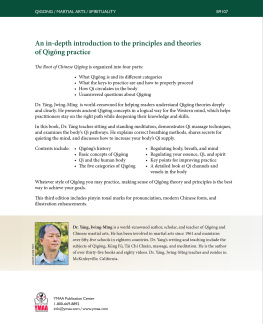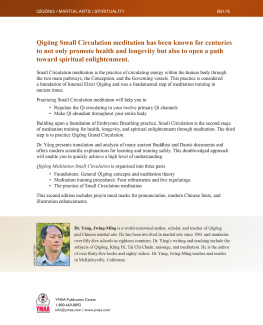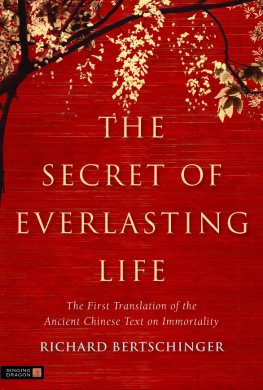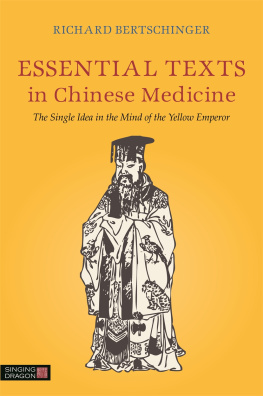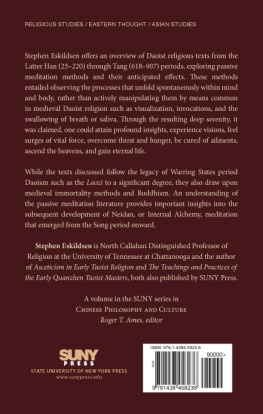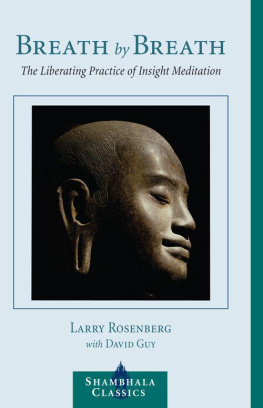A Record of the
Assembled Immortals
and Gathered Perfected
of the Western Hills
Shi Jianwus Daoist Classic on Internal
Alchemy and the Cultivation of the Breath
R ICHARD B ERTSCHINGER
Foreword by Master Zhongxian Wu

C ONTENTS

Foreword
T HE I MMORTALS M ESSAGES
Master Zhongxian Wu
Shi JianWu (780861 CE ), who is also known by his Daoist names, XiZhenZi and HuaYangZhenRen , was a famous Daoist scholar, prolific author and cultivation practitioner from the Tang Dynasty. An astounding number of his poems were showcased in QuanTangShi ( Complete Tang Poems ). Commissioned by the Qing Emperor himself, the QuanTangShi is the largest compilation of Tang poetry to date. Whilst most of the poets represented in this publication had only a few works chosen, this anthology memorialised 197 of Shi JianWus poems. An exceptional human being, Shi JianWu passed up opportunities for the great power and wealth enjoyed by the highest-ranking government officials of the time, becoming one of the rare exceptions of Chinese history a person who prioritised his personal cultivation above all else.
Of all the Daoist classics, I personally believe his work, XiShanQunXianHuiZhenJi ( A True Record of the Assembled Immortals of the Western Hills ), is amongst the best practical texts on internal alchemy and Qigong cultivation.
In the original preface, HuaYangZhenRen states that he deliberately wrote this book in five volumes in order to represent the numerological energy of WuXing (Five Elements). Each volume contains five chapters, which together represent one pure YangQi of each of the Five Elements (in other words, in five there is one).
He also asserts that whilst everyone knows WuXing and the related birth and controlling principles, only a rare few know how to apply these principles to enter the Dao . Whilst everyone also knows the three DanTian and their associations with the Three Layers of JingQiShen , scarcely any know how to circulate them through the three DanTian in order to attain the Dao. From my experience in the Qigong and Daoist cultivation world, I am astonished how little has changed in the last 1200 years!
The teachings of this book are a true treasure trove for the Daoist practitioner. Drawing from cryptic messages of old Daoist masters, the CanTongQi (reputed as the king of internal alchemy classics), and the ZhongLu DanFa (the internal alchemy techniques of Daoist immortals ZhongLiQuan and LuDongBing ), Shi JianWu particularly emphasises the key inner cultivation methods of WuXing and the three DanTian. By doing so, he reminds us of the most essential (and most often overlooked) elements of the Daoist cultivation tradition and modern Qigong practices.
I welcome the birth of the English version of this important internal alchemy classic with enthusiasm! Guided by Richard Bertschingers expert translation and annotations, I hope many people will gain great benefits from this vital work.
A S HORT N OTE ON
R EADING THE T EXT
There are two distinct ways of reading these dense spiritual texts: one is quicker, to let the strange words and passages wash over you without too much thinking what they mean; the other is slower, letting the significance of each phrase resonate in the brain, sparking involvement and depth of feeling. Both are fine, and both okay. Think of it as approaching a banquet some dishes to be savoured, others consumed with their accompanying sauces and condiments easing their passage. You are literally munching meaning. Here is a summary of the highlights.
The first section explains the historical context of this remarkable method of softening the breath. Chapter 1 explains the One Path, the Dao, and is fairly self-explanatory. Chapter 2 tells us that it all hinges on acting naturally. Simply marry together both forms of breathing, the True Yin and Proper Yang, and it is then possible to form an inner Medicine. Chapter 3 explains how to secure this elixial (health-giving) method essentially not to make too much of it, but to remain peacefully and inwardly content without striving. Chapter 4 speaks of timing this action, along with the turning over of the natural world the crux of the affair. This is our task to silently join in fit accord with Yin and Yang, smelting out the True Yin and Yang in the body. This chapter contains the first mention of sustaining that is, sustaining the Yin and Yang of all life. Chapter 5 continues to elaborate on the same theme extracting the True Yin and Yang breaths.
The second section describes further the sustaining. This means sustaining the True Yin and Yang. Chapter 6 explains sustaining life through the quiet withdrawal of the body, and the physical senses. The Zhouyi Cantong Qi concludes: the ear, the eye and mouth, these three jewels, block and stop them up, do not let them gape. Chapters 7 and 8 continue the same theme. Chapter 9 emphasises uncluttering the heart. The final chapter, Chapter 10, points us towards our ultimate goal walking in the divine.
The next section is on rebuilding that is, rebuilding our physical health, fluid-essences, vital breaths, spirit, etc. Chapter 11 is specifically on rebuilding the bodys internal form, and sustaining its five main internal breaths. Chapters 12, 13 and 14 are also on rebuilding and strengthening the five internal organs ( zang ). In Chapter 15 an additional method is given, using the sound, and voicing certain common words, or sounds, under the breath the method of the Six Character Breaths meaning there is sound for each of the main organs. These activities further strengthen the breath.
The penultimate section does no more than verify this remarkable technique. Chapters 1619 elaborate previously described practices, giving the detail. They describe especial alchemic happenings in the body, the merging of the True Yin (fluid) and Proper Yang (breath), forming a state of so-called perfection. Chapter 20 identifies the end of the quest, a quiet and gentle form of foetal breath, as if we were still a foetus in our mothers tummy, breathing out as our mother breathes out and breathing in as she breathes in. This is the highest achievement we are able to attain in this dusty world. It fits and fortifies us with its Great Simplicity.
The last section in the book is on refining the technique. It is achieved through making quiet and settled times during the day to work on the breath. This should be practised at regular intervals, times set aside for just being with the practice. Good luck!
See Chapter 25 in my translation of this foundation text, The Secret of Everlasting Life (Singing Dragon, 2012).
I NTRODUCTION
As I sit back and think about this old text on internal alchemy, I experience afresh the wonder I felt when first deciphering its characters, crouched in a field on the edge of Exmoor, alone on one of my weekend hikes. I remember the astonishment I felt at its clear exposition of Daoist meditation practice and its denigration of unorthodox techniques; its philosophical pairing of sun and moon, the organic duo, the rhythm of Yin and the Yang; the exquisite imagery and simple instruction; the intricate diagrams (of my own creation), illustrating traditional Chinese medicine and an almost arcane approach to the health arts: a picture of the interpenetration of macrocosm and microcosm, the True Breath, Five Elements, water and fire, the human and divine, and much more besides. Its roots go back to the philosophy of the Dao. Dao can be variously translated as Way or Path, and is described well in the seminal Tao-te Ching , foundation text of the Daoists, a motley crew of hermits, proto-chemists, recuperative physicians and great naturalists born in China around 200 BCE to 200 CE .
Next page

